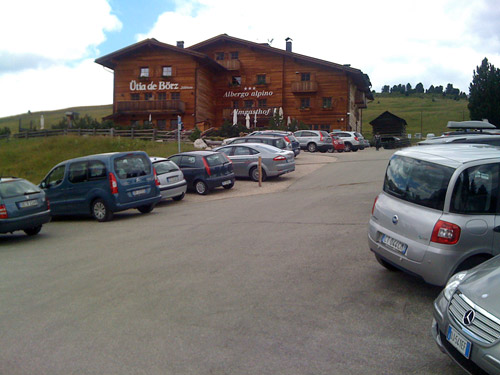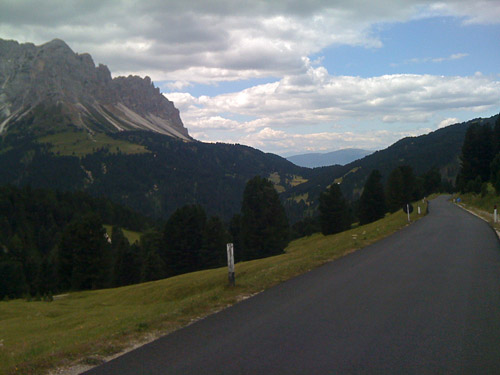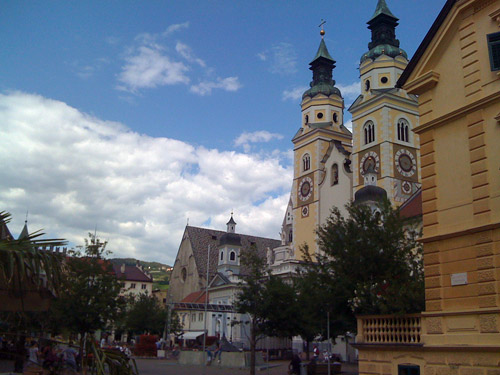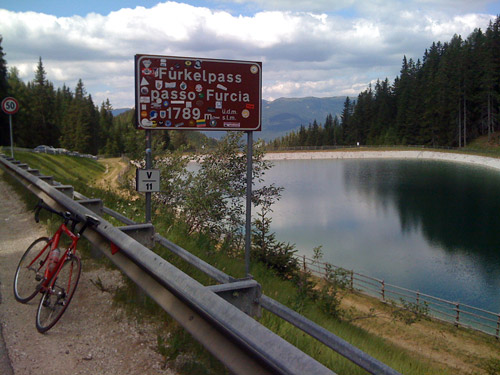
Today were the shortest day on the bicycle until the last day which was similarly short. The reason for this was that I intended to take the train elsewhere in Italy. The idea was to take a train from Chiusa/Klausen to Mondovi in the south of Piemonte (13:55-21:15). This was also a reason for me trying to get to Toblach/Dobbiaco so that I could possibly get to the train in time. Now, it was hard to calculate what road down there I could take on the bicycle or if I had to take a train right at the start in the morning. Having counted on it for some time I decided it should be possible to get over Furkelpass/Passo Furcia/Jù de Furcia (1759m) and Jù de Börz/Würzjoch/Passo delle Erbe (1996m) to Chiusa/Klausen (504m).
So I decided to take this way, but had also wanted as I was now passing over the Furkelpass for the 4th time or so, to visit the famous climb up to Kronplatz/Plan de Corones (2273m) (so being after Giro d’Italia eventually got up there, but it is also a well-know skiing destination). This has a quite steep last stretch on a gravel road to the top, which has been conquered by road bicyclists for a long time. I was perhaps sleeping and enjoying breakfast a little needlessly long in the morning. I left the Toblacher Sattel/Sella di Dobbiaco (1221m) behind me and rolled down the main busy road to the turn-off for Furkelpass at Olang/Valdaora (1005m).
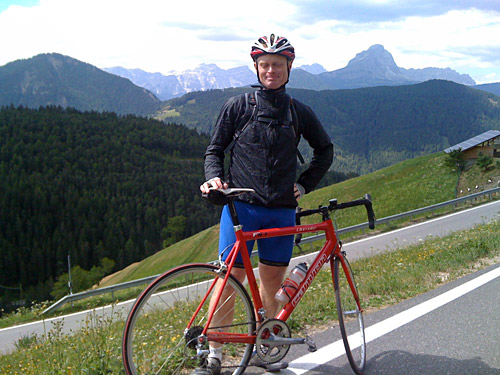
The climb up to Furkelpass/Passo Furcia/Jù de Furcia (1759m) felt easy and I passed by some other riders up there (maybe because I knew the climb and it was the first in the day). I started out a little on the road up to Kronplatz/Plan de Corones which had a concrete surface at the start and did not look too bad, but I counted on the time I had before I needed to be in Klausen/Chiusa and there was simply no way that I could make this climb and still be there in time, so regretfully I had to leave it and go ahead.
I soon met a cyclist on the steep road down to Zwischenwasser/Longega (1012m) who asked if it was long to the pass as he was getting very tired. I stopped and took a photo and he took one of me. Down at Zwischenwasser/Longega I took the road via Rina/Welschellen to Jù de Börz/Würzjoch/Passo delle Erbe (1996m) as I had planned, but got surprised by road work and a sign suggested that one should take another road up there. From now on I realised I was in a hurry if I should have any chance to get to the train and I went in a good speed up here and luckily the road was passable even though very few cars used it.
This climb up to Würzjoch might be the hardest of all the climbs up there, but for some reason there is no publicly available profile for the full climb up there (that I know of). It is also quite a nice climb like most climbs in the Dolomites, but this is also relatively hard. The steepest stretch is when getting out of Antermëia/Antermóia/Untermoi (1515m) at ca. 16%. There is also a little descent after Rina before climbing up through Antermëia.
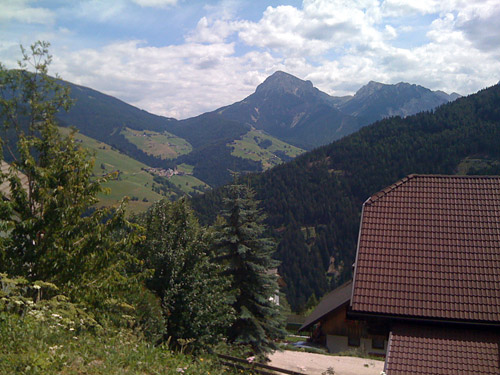
All the places here around has at least three names: local Ladin, Italian and German. I sometimes list the variants in different order (trying to list the name first that I suspect is the most commonly used name locally) and I have come to learn that you cannot be sure of what version the locals are using as sometimes even German speaking people use the Italian version and the Ladin speaking might use the German version, but Italian speaking people are likely to always use Italian names. The Ladin speaking ones probably do not use the Ladin term in talking to you as they suspect you do not know it and they might well not even know it themselves for a few places. One of the most commonly known ladin name for a pass is the Jëuf de Frea (which has recently started to be sign-posted for as Ju de Frara in Alta Badia) (Grödnerjoch/Passo Gardena). Some might argue that since this area is part of Italy since way back now, the Italian names should be mentioned first, but it does not make much sense to use the translations into Italian when few near the pass speaks Italian. Up in the mountains the German names usually makes most sense unless the Italian names has become too popular (like Passo Sella), but sometimes I think the Ladin names might be best after all (at least if they were not slightly different from valley to valley).
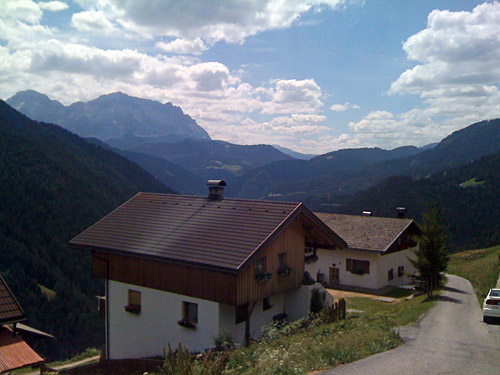
The views up at Jù de Börz/Würzjoch/Passo delle Erbe are great! My special interest upon this revisit of the pass was to try and get a visual confirmation about the exact height of the pass as this has been under some discussion since maps have been rather unclear on this down through history. It is usually supposed to be higher than the mythic 2000m mark as noted on some maps, while the relatively new sign there says it is only 1987m. Consulting various layers of the technical regional maps in conjunction with other maps, gives away that neither of these measures are correct. But what is the correct height? There is no exact measurement at the exact pass point given anywhere. The most up-to-date topographical height curves on maps at 1:5000 makes the height for the hotel, Ütia de Börz, not 2006m as is written on the building and refers to an earlier building on the other side of the historical track going just behind the house (or if this is wrong, then this figure is still not correct). Given these maps, the house is at exactly 2000m height and I do not think it is more than ca. 4m higher than where the parking in front of it starts (the pass), but see the photo here below (judging from photos is near hopeless, I know). One detailed local walking map also marks the pass at 1998m (which is the lowest any map gives for the pass). Thus, I say 1996m, and for sure within 1992-1998m. Also remember to consult my list of the highest paved passes of the Alps where this pass has further descriptions.
Now, it was full speed down to try and catch the train. the clock was exactly 13 as I left the pass. But even if it is mostly downhill, then it takes time to descend too. It was close to 30 km to the train station and I wold do well to be there before the train left as I would really need to buy a ticket and get hold of some plastic bags to wrap my bicycle up in so that I could claim it is just ordinary baggage as one needs on at least one stretch on this journey. Now you guess it seemed a little futile, but I was trying to do it. I guess few people have made the descent and climb up to Halsl/Passo Rodella (1866m) as quickly as I did and then I continued to really push all the way down over Russiskreuz (1729m) and then down the steep road to Villnößtal/Val di Funes. The most dangerous was perhaps the speed I allowed myself further down this valley on the main road, where I just about managed to handle the curves. Then I got over on the other side of the river, which was perhaps not so good as I had to find and cycle a bit of the way back again through Chiusa/Klausen (German speaking people apparently call it Chiusa too). I even had to stop and ask if I was on the right road to the train station as the signs were poor here.
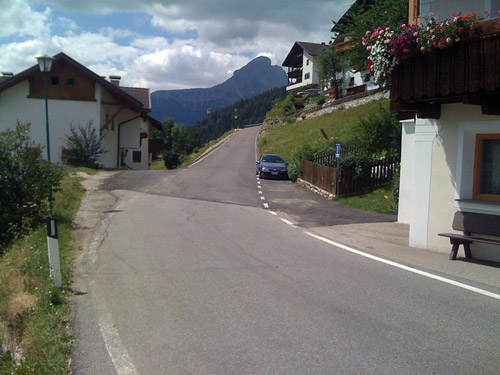
At 14 sharp I entered the station and ha d seen no train come and go as I went into Chiusa/Klausen, so hoped that the train might have been a little late. At once I saw a train at the station and thought that it must be it and jumped on. The doors closed and I asked if it was going to Bolzano, but no. It was going in the other direction up to Austria. Well, I tried my best. Should have been up earlier in the morning. Always being optimistic about the time I have at hand. Anyway I jumped off again at the next station in Bressanone/Brixen and was very happy I had not seen any train personnel as I had no ticket, but had hoped to buy a ticket on the train (but in Italy one could possibly get a fine if trying this).
Oh well, I had to take the next train instead, which was going two hours after the first (15:55 from Chiusa thus and a bit earlier from Bressanone). That gave me time to eat lunch in Bressanone and look around and try to find plastic bags for my bicycle (which I had some problems with just in Bressanone another year, which was part of the reason for trying Chiusa instead this time). Bressanone is a busy town with a nice old city centre, but most people where absolutely not very nice here (typical for modern bigger cities, I guess) – maybe I had been too long out in the countryside. I found a rather bad place for lunch, then a not so good place for an ice cream by the square in the centre. Then I tried to find plastic bags at some grocery shops and super markets, but had no luck at all as all they sell are smaller bags for the kitchen.
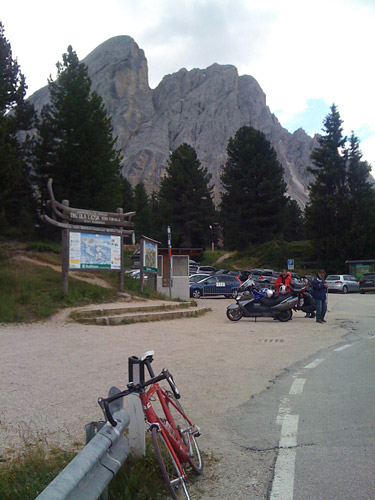
Eventually, as time dragged on, I got a little desperate and decided it was time to think hard and be clever. I walked in to the hotel next to the train station and asked them. The lady there at first would not understand me, but I was not going to be misunderstood this time and explained that they must have people cleaning the hotel and they likely would use plastic bags of the size I was looking for, so perhaps she could have a look among their equipment. Sure enough, she came back with two big black plastic bags and I asked here to get a third and gave her some money (being friendly). She was also nice and we joked that maybe she could start a business in selling plastic bags on the side!
I just got the bicycles and wheels that I took off covered as the train came in and off I went to Bolzano, Verona, and Milano. Now, I was on a so-called ‘fast’ Italian train, but had bad memories of the train ride to Verona from Milano some years ago and sure enough this train was also not going on time. This train needed to be on time if I should have any chance of getting all the way to Mondovi this day, which was why I had not planned to take it. It felt like forever before it reached Milano. Me and a lady, who I had started talking with who was also looking for the same connection, started run over to the track for the train down to Piemonte, but we could only see it disappear out of the central.
I looked up the time schedules and possibilities and noted that I could get part of the way down there before midnight, but it was already after 19 now, I think, and it was another hour before the next train should leave. I walked around a bit on the station pondering this and then came to think that I had indeed talked with a cyclist partly living in Milano – Gabriele, who had invited me to the great bicycle meeting in Liguria the year before and we had discussed my plans for this Summer a bit before I left. As it happened I had saved his phone number on my iPhone and thus could not resist to give him a call and see if he possibly was in town and had time and maybe even place for me for the night. And, as I told you before, I was lucky on this Summer trip! Gabriele was at home and not busy with anything special else (or so he told me). He came down and picked me up.
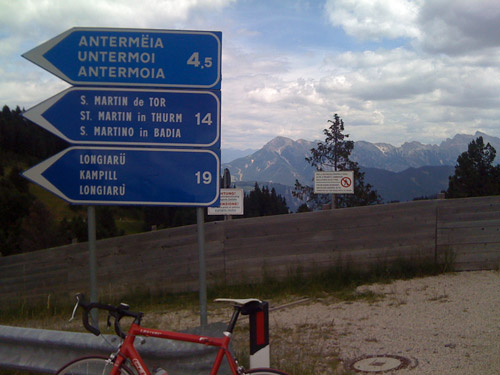
Gabriele is a doctor and has a fine apartment in the centre, not so far from the fashion district. I took a quick shower and then we bicycled out on the town on some of his old bicycles to see the big Duomo (that I saw on my first travel down in Europe a long time ago now) and we cycled through the fashion district and by the La Scala. we walked with the bicycles across the nice old gallery (where it is not popular to bicycle). Then we went to his daughter’s favourite ice cream place (quite good). Maybe we had a pizza before we went out on town (I think so). Then we eventually came back again. I surely will never remember those roads, but it was all fun and it was a nice warm evening. We then sat talking about mountain passes and so for some time before I had to wash my clothes and go to bed. I got a great tip also for the next day from Gabriele for my route choice, which came in very handy (more on this the next day). What I remember most of Gabriele’s nice apartment was the peculiar arrangement for drying clothes, which I have never seen before. One had to drag them down with a long stick from the ceiling (hard to describe … ) – a clever arrangement for those with high ceilings! The stay was superb and I am really very thankful for Gabriele’s kind hospitality! Who knows where I had ended up this evening otherwise … (just have a look on what happened the next evening … ).
